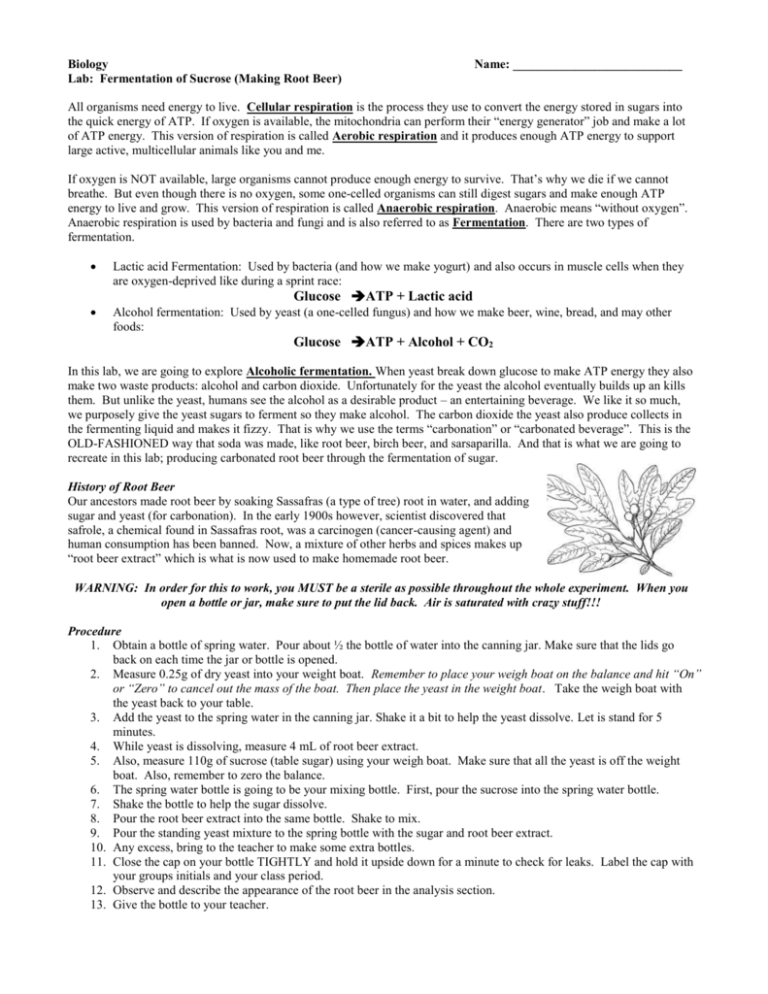Biology Name: Lab: Fermentation of Sucrose (Making Root Beer) All
advertisement

Biology Lab: Fermentation of Sucrose (Making Root Beer) Name: ___________________________ All organisms need energy to live. Cellular respiration is the process they use to convert the energy stored in sugars into the quick energy of ATP. If oxygen is available, the mitochondria can perform their “energy generator” job and make a lot of ATP energy. This version of respiration is called Aerobic respiration and it produces enough ATP energy to support large active, multicellular animals like you and me. If oxygen is NOT available, large organisms cannot produce enough energy to survive. That’s why we die if we cannot breathe. But even though there is no oxygen, some one-celled organisms can still digest sugars and make enough ATP energy to live and grow. This version of respiration is called Anaerobic respiration. Anaerobic means “without oxygen”. Anaerobic respiration is used by bacteria and fungi and is also referred to as Fermentation. There are two types of fermentation. Lactic acid Fermentation: Used by bacteria (and how we make yogurt) and also occurs in muscle cells when they are oxygen-deprived like during a sprint race: Glucose ATP + Lactic acid Alcohol fermentation: Used by yeast (a one-celled fungus) and how we make beer, wine, bread, and may other foods: Glucose ATP + Alcohol + CO2 In this lab, we are going to explore Alcoholic fermentation. When yeast break down glucose to make ATP energy they also make two waste products: alcohol and carbon dioxide. Unfortunately for the yeast the alcohol eventually builds up an kills them. But unlike the yeast, humans see the alcohol as a desirable product – an entertaining beverage. We like it so much, we purposely give the yeast sugars to ferment so they make alcohol. The carbon dioxide the yeast also produce collects in the fermenting liquid and makes it fizzy. That is why we use the terms “carbonation” or “carbonated beverage”. This is the OLD-FASHIONED way that soda was made, like root beer, birch beer, and sarsaparilla. And that is what we are going to recreate in this lab; producing carbonated root beer through the fermentation of sugar. History of Root Beer Our ancestors made root beer by soaking Sassafras (a type of tree) root in water, and adding sugar and yeast (for carbonation). In the early 1900s however, scientist discovered that safrole, a chemical found in Sassafras root, was a carcinogen (cancer-causing agent) and human consumption has been banned. Now, a mixture of other herbs and spices makes up “root beer extract” which is what is now used to make homemade root beer. WARNING: In order for this to work, you MUST be a sterile as possible throughout the whole experiment. When you open a bottle or jar, make sure to put the lid back. Air is saturated with crazy stuff!!! Procedure 1. Obtain a bottle of spring water. Pour about ½ the bottle of water into the canning jar. Make sure that the lids go back on each time the jar or bottle is opened. 2. Measure 0.25g of dry yeast into your weight boat. Remember to place your weigh boat on the balance and hit “On” or “Zero” to cancel out the mass of the boat. Then place the yeast in the weight boat. Take the weigh boat with the yeast back to your table. 3. Add the yeast to the spring water in the canning jar. Shake it a bit to help the yeast dissolve. Let is stand for 5 minutes. 4. While yeast is dissolving, measure 4 mL of root beer extract. 5. Also, measure 110g of sucrose (table sugar) using your weigh boat. Make sure that all the yeast is off the weight boat. Also, remember to zero the balance. 6. The spring water bottle is going to be your mixing bottle. First, pour the sucrose into the spring water bottle. 7. Shake the bottle to help the sugar dissolve. 8. Pour the root beer extract into the same bottle. Shake to mix. 9. Pour the standing yeast mixture to the spring bottle with the sugar and root beer extract. 10. Any excess, bring to the teacher to make some extra bottles. 11. Close the cap on your bottle TIGHTLY and hold it upside down for a minute to check for leaks. Label the cap with your groups initials and your class period. 12. Observe and describe the appearance of the root beer in the analysis section. 13. Give the bottle to your teacher. What are our next steps??? We will age the bottle for 2-3 weeks at room temperature in a dark place. After that we will refrigerate for 1 week. Refrigeration will stop the fermentation process and kill the yeast – and stop us from producing alcohol (Sorry!!!) Be sure to check the bottles ever day for tightness, if they get too pressurized, they will burst. After chilling, get your bottle, open carefully, pour a sample into a cup and observe and record the appearance of the root beer. Drink up!!!! Analysis – After Set-up 1. Describe the appearance of the root beer before the fermentation process. 2. Why was the yeast necessary in this experiment? 3. Why was the sucrose necessary in this experiment? 4. What is the yeast trying to do with the sugar? 5. What is carbon dioxide to the yeast? 6. What is the alcohol to the yeast? 7. Why do we have to leave the bottle for a few weeks before we drink it? 8. Is the yeast using anaerobic or aerobic respiration? Explain. 9. Could we survive using this same process? If not, why not?






